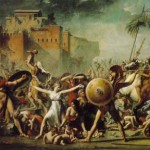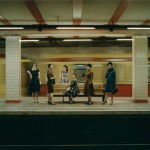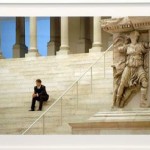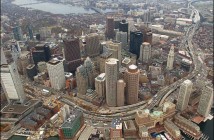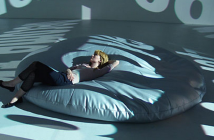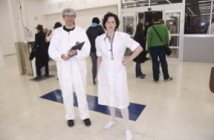Eve Sussman has risen to international renown over the past two years since her ’89 Seconds to Alcazar’ premiered at the Whitney Biennial two years ago. The piece, a tableau vivant of Velasquez’ Las Meninas, addresses the interior fictions of the original painting. I have written about this piece before for BRS, "Breaking The Video Frame" in issue #8. At that time I was most concerned with a certain inflation of the medium as it rose into the temple of high art. The piece was fascinating, elegant, monumental and made with the latest technology, state of the art at the time.
The popularity of the previous work and the sensation it created produced a financial reward that has now been turned toward the production of Sussman’s latest piece, The Intervention of the Sabine Women. With the Rufus Corporation, a group of actors, technicians, sound and movement coordinators (she brought 12 people with her to the lecture!), Sussman is in post-production phase of the creation of the piece. The presentation at the Clark was an opportunity to screen clips from various locations and to discuss the artist’s conceptual ground.
The myth itself has everything to do with desire, as it opens up the story of the expansion of ancient Rome by force of rape. The Sabines lived in the countryside outside Rome, and the Romans launched an attack on their women, abducting them and taking them back to Rome where they lived and built families. Eventually the Sabine men retaliated, meeting the Romans in battle. On the field the women and children surged en masse and came between the two armies. In this ecstatic gesture, the women forced the unification of these two cultures and the expansion of Rome.
Sussman has adapted this story to a 1960’s context. The art direction recalls the styling of European films of the era: Renais’ Last Year at Marienbad, Fellini’s La Dolce Vita, Antonioni’s Red Desert, and from an earlier era the tormented bodies of the ‘battle’ scenes Eisenstein’s Potempkin. Sussman has shot the piece in Greece and Berlin in the site of Fascist architecture of the Berlin Airport or the classical arenas of the Pergamon Museum, an ancient stone amphitheater and a stark soccer field. The imagery is gorgeous, evocative, and derivative.
When asked to comment on the ‘cinematic’ references which are clearly her sources, Sussman demurred. She calls this work ‘video art’ at the same time she is making references to dance (I could see some Meredith Monk and Yvonne Rainer). Then there were the theatrical tropes, the set pieces, the performance of pathos, and as well something that tried to be sexually driven but felt oddly sexless, soul-less. There were contexts abounding that should have generated psychological tension, but that for me seemed vapid and listless. All this in the terms that might be literary, but that ended up as spectacle.
In the end the work couldn’t hold a candle to Alcazar (of course it isn’t complete yet) in focus and as a critical work. There are loose references to a kind of feminist revolt, but mostly it breaks down into a lot of bodies rubbing against each other. It could be a critique of bourgeois complacency, and the fascist order that keeps the comfort zone intact, but it lost its thunder in the excesses of its production values and costs.
Somebody has desire in this mix. Sadly mine wasn’t whetted.
Links:
Clark Art Institute
Eve Sussman and the Rufus Corporation Lecture was held October 10, 2006 at the Sterling and Francine Clark Institute, Williamstown, MA
All images are courtesy of the artist the Sterling and Francine Clark Institute.


